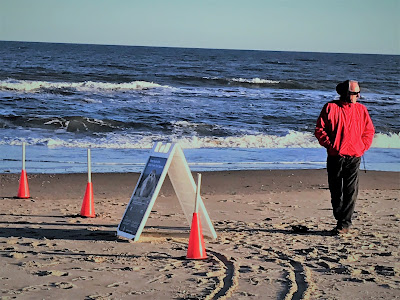SEAL RESCUE
ON THE MARYLAND SHORE
Cold,
blustery days don’t always keep Ocean City residents and visitors off the beach. For those who hang around long after the
summer season, late autumn and winter are some of the very best times to walk
the strand. The population is reduced to
what often feels like a small church congregation, and most of those who
venture down to the water feel a kind of ownership, as if our broad beaches
were a part of the personal real estate that we all own or rent.
On one
such day, the winds had settled down enough for me to venture out and enjoy the
incredibly blue sky they left behind. Just
three blocks from where I call home, a sizeable gray lump came into view, not
far from the water’s edge. My first
thought was that it looked like an
inflated fur coat. As I drew closer, the
term ‘beached whale’ came to mind, but the lump in question was much too small
for that. Just then, an endearing
cartoon face glanced back at me over the lump’s shoulder. Seals do have a way of looking exactly like
the drawings of them we see in children’s books.
This
one appeared healthy enough, sufficiently so to throw an unexpected honk—or was
it a bark— in my direction. It was
holding a position that I later learned was a healthy, sort of flexed- banana
pose, and as I steered clear to pass up that mismatched voice and face, the
seal managed a slight sideward roll to keep me in view. From that vantage point, I couldn’t help but
notice the tip of a bloody gash on its underside, most of which was pressed
hard to the sand. Some combination of
Good Samaritanism and Smalltown Ways kicked in, and I called 911.

My call
triggered a range of contacts that mobilized a whole professional and volunteer
community, which really cared about our distressed visitor no matter how ornery
its bark. Police Department Animal
Control personnel contacted Jennifer Dittmar, manager of the National Aquarium’s
Marine Animal Rescue Program and the person in charge of volunteer training, which
usually takes place at area libraries and restaurants. She immediately
contacted local marine animal first-responder volunteers and Sandi Smith. Sandi is the development and marketing
coordinator for the Maryland Coastal Bays Program. who coordinates the seal
stewards program and arranges for volunteers to monitor the haul-out site, a somewhat
graphic term designating the spot where the seal decided to come ashore.

First responder Tom Erbe was equipped with
high-definition photo lenses. He took
pictures of the seal and sent them to a team of experts, including biologists
and veterinarians at the National Aquarium.
The wound on the little fellow, who we finally couldn’t help but call
Sammy, really told the story. But the
National Aquarium team was looking for other signs of distress, such as unusual
clouding of the eyes or being underweight.
While Jennifer Dittmar got everything underway, Sandi Smith dispatched
periphery cones, brochures, and sandwich board signs to assist the volunteer
monitors in their task of giving the seal all the room it needed to
survive.
Once the
team of experts determined the seal was not in jeopardy, first responders Chuck
and Ellen Erbe came down to the beach with an oversized dog kennel and a
makeshift baffle board arrangement for coaxing the seal into it, in preparation
for its ride to the Aquarium. The
Baltimore Aquarium is one of three available sites providing care. The Virginia Aquarium and Marine Science
Center in Virginia Beach, like Baltimore, has place for only a couple of these
cases, and the Marine Mammal Stranding Center in Brigantine, New Jersey, has
the most spacious facility for the purpose.
These three centers work together for effective intake and
treatment. Our Sammy spent an overnight
in Baltimore being stitched up, then was sent off to Brigantine for recovery
and re-release two months later.


All I
had seen during that coaxing process was a cantankerous animal that really didn’t want to be there. It took a while to calm him down—soothing
tones, a little light whistling, and some very slow and quiet movement
helped. Remarkably, he never stopped looking
adorable—which is part of the challenge. People want to walk right up to a seal and
get in really close, forgetting that from the seal’s perspective we probably
look more like grizzly bears than playmates.
As with other wild animals, any kind of human intervention can be very
stressful, even if the seal is sick or injured.
When they feel threatened they can bite, and they are susceptible to a
range of diseases that include herpes and rabies. For that reason, volunteer monitors,
brochures, and sandwich boards all emphasize the importance of maintaining that
‘safe distance’.

I was
a little surprised to learn that the recommended distance is as much as four or five car lengths due to the
stress factor. For humans under stress, a
weekend in Disneyland or Vegas may be all we need. But much more quickly for seals than for us,
stress in the wild can be a real killer.
Seals haul out on the beach to rest from their journey, from their
search for food, or possibly from a shark that has tried to turn them into a
tasty morsel. The Marine Mammal
Protection Act is in place to remind us that these animals need undisturbed
rest to stay healthy and alive, and to protect them with a potential fine of up
to $500 for human harassment.

Seals—harp
seals, harbor seals, hooded seals, gray seals—may very well be the center
attraction. But they’re not all there is
to the show. Maryland Coastal Bays
Program staff meet with passing residents and visitors near seal haul-out
locations to educate them on seal behavior and to provide photo oppportunities
at a respectful distance. Observers are cautioned not to send out seal
location details on general social media in order to prevent a large crowd from
gathering. But the crowd that does
gather—normally a fluid group of anywhere from two to ten people—offers a great
way to share warmth on a cold day, to provide children with mini-lessons on
nature, to appreciate the beauty around us, or just to participate in ‘why we
do this’.

Migrating from northern New England
to North Carolina, seals travel our coastal waters throughout the winter. Their populations have increased, which means
that sightings and strandings along the Mid-Atlantic coast have become more
frequent. Volunteer coordinator Sandi
Smith feels “it’s exciting to have a winter visitor, and the seals are all a
part of our circle of life. It’s nice to
be able to protect them, and perpetuate that whole circle. Back before the seal steward program started,
Ocean City Animal Control was the only one out there, and it was really tough
on them. So it seemed like a good idea
to support them and develop the current program.”

The extended outreach program focuses
on educating Mid-Atlantic coastal communities regarding the roles individuals
play in supporting healthy ecosystems for marine mammal populations. The National Aquarium Marine Animal Response
Team numbers more than a hundred volunteers, and over the years productive
partnerships have been developed with the City Council, the Coast Guard, the Maryland
Department of Natural Resources, Coastal
Fisheries, and local water-recreational businesses from jet skis to the
National and State Parks of Assateague Island.
I asked Sandi, “With all the
stakeholders involved in this network, who is it that finally decides when the
seal has had enough intervention?” She
didn’t need to think very long for her reply—
“The seal does.”
Of course.
© Copyright 2017 by Cary
Kamarat . All rights reserved.
Please share your travel
experiences and impressions by clicking on the word ‘comments’ below.






































































